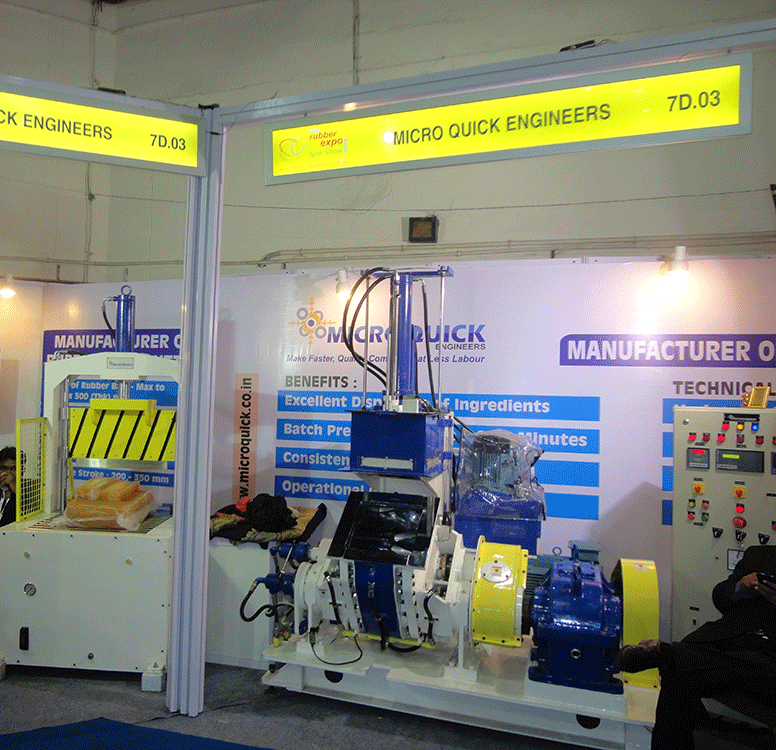Rubber compound quality plays a crucial role in various industries. From automotive to healthcare, the performance and durability of rubber products are directly linked to the quality of the compounds used in their manufacturing.
The Role of Hydraulic Dispersion Kneaders
One key factor that can significantly enhance the quality and efficiency of rubber compounding is the use of hydraulic dispersion kneaders . These advanced mixing machines excel in achieving excellent dispersion of ingredients and consistent quality compounding.
Hydraulic dispersion kneaders offer industry-leading performance, reducing batch preparation times to just 7-12 minutes with automated continuous hydraulic ram pressure. This not only saves time but also ensures uniform mixing and improved batch consistency.
Microquick Engineers: A Trusted Manufacturer
Microquick Engineers, a leading manufacturer and exporter, specializes in producing high-quality hydraulic dispersion kneaders. With over 25 years of experience in the industry, they have established themselves as a trusted name.
Their kneaders are designed with wear-resistant properties, ensuring durability and long-term performance. The innovative shaft seals with lubrication passage prevent ingredient leakage, further enhancing the efficiency of the mixing process.
Revolutionizing the Rubber Compounding Process
In this blog post, we will explore the importance of rubber compound quality in various industries and delve into the role of hydraulic dispersion kneaders in improving quality and efficiency. Stay tuned to discover how these advanced machines can revolutionize the rubber compounding process and elevate the overall performance of rubber products.
Understanding Rubber Compounding
Rubber compounding is a crucial process in the rubber industry that involves the mixing of various ingredients to create rubber compounds with specific properties and characteristics. These compounds are used
in a wide range of applications
, from automotive tires to industrial seals. The quality and efficiency of the rubber compounding process play a vital role in determining the performance and durability of the final rubber products.
To understand the significance of rubber compounding, let’s first define what it entails. Rubber compounding is the process of combining raw rubber with other additives, such as fillers, curing agents, plasticizers, and antioxidants, to achieve the desired properties of the final product. This process is essential because raw rubber alone does not possess the necessary characteristics, such as strength, elasticity, or resistance to heat and chemicals, required for specific applications.
Quality and efficiency are paramount in rubber compounding. High-quality rubber compounds ensure that the final products meet the required performance standards and have the desired properties. Efficiency, on the other hand, refers to the ability to produce rubber compounds consistently and in a timely manner. Efficient rubber compounding processes minimize waste, reduce production costs, and enable manufacturers to meet market demands effectively.
Challenges in Rubber Compounding
However, the rubber compounding process is not without its challenges. One common challenge is achieving proper dispersion of the ingredients. The ingredients in rubber compounds need to be thoroughly mixed to ensure uniformity and prevent the formation of lumps or clusters. Inadequate dispersion can lead to variations in the properties of the final product, compromising its performance and quality.
Another challenge is achieving consistent quality in large-scale production. Rubber compounding is often done in batches, and maintaining consistent quality across different batches can be difficult. Variations in ingredient proportions, mixing times, or processing conditions can result in differences in the final product’s properties. Manufacturers need to implement strict
quality control measures
to ensure consistency and minimize variations.
Rubber compounding is a vital process in the rubber industry that involves mixing various ingredients to create rubber compounds with specific properties. The quality and efficiency of the compounding process directly impact the performance and durability of the final rubber products. Challenges such as achieving proper ingredient dispersion and maintaining consistent quality need to be overcome to ensure the production of high-quality rubber compounds.
Hydraulic dispersion kneaders are an essential tool
in the rubber compounding industry
, offering a highly efficient and effective way to mix rubber compounds. These kneaders are designed to ensure the proper dispersion of ingredients, resulting in consistent and high-quality rubber compounds.
Definition and Working Principle
Hydraulic dispersion kneaders are mixing machines that use hydraulic pressure
to mix rubber compounds
. The working principle of these kneaders involves the use of a mixing chamber and two counter-rotating rotors. The rotors are driven by a hydraulic system, which applies pressure to the rubber compound and forces it through the narrow gap between the rotors. This action leads to the dispersion of ingredients and the creation of a homogenous mixture.
Key Components
- Mixing Chamber: Designed to withstand high pressure and temperature, the mixing chamber is where the rubber compound is fed and mixed.
- Rotors: Responsible for the kneading action, the rotors have specific profiles and are made from materials with excellent wear resistance properties.
Features
- Automation and Continuous Hydraulic Compression: Allows for precise control of the mixing process, reducing batch preparation times to as little as 7-12 minutes.
- Excellent Dispersion of Ingredients: The narrow gap between the rotors creates a shearing action that breaks down the rubber compound and disperses the ingredients evenly.
Advantages over Other Mixing Technologies
When compared to other mixing technologies for rubber compounding, hydraulic dispersion kneaders offer several advantages:
- Excellent dispersion and homogeneity
- Automation and continuous hydraulic compression
Hydraulic dispersion kneaders are a crucial tool in the rubber compounding industry, offering excellent dispersion and consistent quality. With their key components and features, these kneaders provide a reliable and efficient solution for producing high-quality rubber compounds.
Microquick Engineers,
with over 25 years of experience
in the industry, is a trusted manufacturer and exporter of hydraulic dispersion kneaders. Their kneaders
have low energy consumption
and are suitable for various industries. To learn more about their hydraulic dispersion kneaders, you can visit their website, where you’ll find a video library showcasing their products and positive testimonials from satisfied customers.
Advantages of Hydraulic Dispersion Kneaders in Rubber Compounding
Hydraulic dispersion kneaders have revolutionized
the rubber compounding industry
by offering several advantages over traditional mixing methods. These kneaders ensure improved dispersion of ingredients, leading to better compound quality and enhanced properties. Here are the key advantages of
hydraulic dispersion kneaders
:
-
Improved Ingredient Dispersion:
Traditional mixing methods struggle to achieve uniform distribution of ingredients, resulting in poor compound quality and inconsistent performance. Hydraulic dispersion kneaders use a unique mixing action that ensures thorough dispersion of ingredients, leading to compounds with enhanced properties and performance. -
Reduced Batch Preparation Time:
Traditional mixing methods often require multiple steps and manual interventions, leading to time-consuming batch preparation processes. However, hydraulic dispersion kneaders employ automated continuous hydraulic compression, which significantly reduces the batch preparation time to just 7-12 minutes. This automation not only saves time but also ensures consistent quality and eliminates human error in the mixing process. -
Enhanced Durability and Wear Resistance:
The mixing chamber and rotors of hydraulic dispersion kneaders are designed to withstand the intense shear forces and abrasion that occur during the mixing process. This ensures the longevity of the kneader and minimizes the need for frequent maintenance and replacement of parts, resulting in cost savings for the users. -
Prevention of Ingredient Leakage:
Hydraulic dispersion kneaders are equipped with specially designed shaft seals that incorporate lubrication passages. These passages ensure continuous lubrication of the seals, preventing ingredient leakage and ensuring the integrity of the mixing process. This feature is particularly crucial when working with expensive or hazardous ingredients, as it eliminates the risk of product loss or contamination. -
Low Energy Consumption and Versatility:
Hydraulic dispersion kneaders are designed to optimize energy efficiency, minimizing power consumption and reducing operating costs. Additionally, their versatility allows them to be used in a wide range of industries, including automotive, industrial manufacturing, consumer products, healthcare, and the electrical industry.
The Applications and Benefits of Hydraulic Dispersion Kneaders
Hydraulic dispersion kneaders have revolutionized various industries by improving
the quality and performance of rubber
parts, enhancing functionality and durability, and meeting stringent quality standards. Here are the key applications and benefits of
hydraulic dispersion kneaders
:
Automotive Industry
- Improved quality and performance of rubber parts
- Efficient mixing of rubber compounds
- Better dispersion of ingredients
- Consistent quality compounding
- Superior performance and durability of rubber parts
Industrial and Consumer Products Sector
- Enhanced functionality and durability
- Better dispersion of fillers and additives
- Improved mechanical properties of final products
- Longer service life
- Superior performance in harsh operating conditions
Healthcare and Electrical Sectors
- Meeting stringent quality standards
- Excellent dispersion of ingredients
- Consistent quality in rubber compounds
- Safety and reliability of medical equipment and electrical insulation materials
The versatility and effectiveness of hydraulic dispersion kneaders make them valuable in various industries. They offer unparalleled advantages in terms of quality, performance, and durability of rubber compounds.
Microquick Engineers: Trusted Manufacturer and Exporter
Microquick Engineers is a trusted manufacturer and exporter of hydraulic dispersion kneaders. With over 25 years of experience, they deliver high-quality solutions that meet the specific needs of their customers. Key features of their kneaders include:
- Innovative designs with wear-resistant mixing chambers and rotors
- Advanced shaft seals with lubrication passages to prevent ingredient leakage
- Energy-efficient design for cost savings
Visit Microquick Engineers’ website to learn more about the applications
and benefits of hydraulic dispersion
kneaders. Their website features a video library showcasing their products and positive testimonials from satisfied customers. Whether you’re in the automotive industry, manufacturing
industrial and consumer products
, or operating in the healthcare and electrical sectors, hydraulic dispersion kneaders from Microquick Engineers can significantly enhance the quality, performance, and durability of your rubber compounds. Choose them for innovative solutions that meet your industry’s requirements and propel your business forward.
Microquick Engineers: A Trusted Manufacturer and Exporter
Microquick Engineers is a trusted manufacturer and exporter
of hydraulic dispersion kneaders
, with expertise in providing high-quality solutions
for the rubber compounding industry
. With over 25 years of experience, Microquick Engineers has established itself as a reliable and innovative player in the market, delivering industry-leading performance and excellent compounding results.
One of the key reasons why Microquick Engineers is highly regarded in the industry is their deep understanding of the requirements
and challenges of rubber compounding
. They have developed hydraulic dispersion kneaders that address these challenges and offer superior performance. These kneaders are designed to provide excellent dispersion of ingredients, ensuring consistent and high-quality compounding results.
Advanced Features and Capabilities
- Incorporates automation and continuous hydraulic ram pressure
- Reduces batch preparation times to just 7-12 minutes
- Improves efficiency and allows for faster production cycles
Microquick Engineers’ hydraulic dispersion kneaders stand out for their advanced features and capabilities. They incorporate automation and continuous hydraulic ram pressure, reducing
batch preparation times
to just 7-12 minutes. This not only improves efficiency but also allows for faster production cycles, enabling manufacturers to meet the demands of a rapidly changing market.
In addition to their efficiency, Microquick Engineers’ hydraulic dispersion kneaders are also known for their operational convenience. The mixing chamber and rotors are designed with wear-resistant properties, ensuring durability and long-lasting performance. The kneaders also feature innovative shaft seals with lubrication passage, preventing ingredient leakage and ensuring a clean and efficient mixing process.
Commitment to Customer Satisfaction
Microquick Engineers’ commitment to customer satisfaction is evident in their strong track record of delivering high-quality products and excellent service. Their experience of over 25 years has allowed them to understand the unique needs of their customers and develop solutions that meet and exceed their expectations. Their dedication to customer satisfaction has earned them a loyal customer base and a reputation for being a trusted manufacturer and exporter in the industry.
The Future of Rubber Compounding
The future of rubber compounding is an exciting and rapidly evolving field. As new technologies emerge and manufacturing plants advance, the industry is poised for growth and recovery. In addition, the potential of artificial intelligence (AI) in rubber compounding holds promise for further advancements. Let’s explore each of these aspects in more detail.
Emerging Trends
Emerging trends in the rubber compounding industry are driving innovation and pushing the boundaries of what is possible. Manufacturers are constantly seeking ways to enhance the performance and functionality of rubber compounds to meet the ever-increasing demands of various industries. From automotive to healthcare, rubber compounds play a crucial role in the development of products. By staying updated with the latest trends, manufacturers can stay ahead of the competition and meet the evolving needs of their customers.
Advancements in Manufacturing Plants and Technologies
Advancements in manufacturing plants and technologies have revolutionized the rubber compounding process . One notable innovation is the introduction of hydraulic dispersion kneaders . These machines offer industry-leading performance and excellent compounding results. With automated continuous hydraulic ram pressure, batch preparation times are significantly reduced, resulting in improved efficiency and productivity. This not only saves time but also allows manufacturers to meet tight production schedules.
Growth and Recovery of the Rubber Compound Market
The growth and recovery of the rubber compound market are being driven by increased demand from various industries. As the global economy recovers from the impact of the COVID-19 pandemic, industries such as automotive, industrial manufacturing, consumer products, healthcare, and electrical are expected to drive the demand for rubber compounds. Manufacturers who can provide high-quality compounds efficiently will be well-positioned to capitalize on this growth.
Potential of Artificial Intelligence
The potential of artificial intelligence in rubber compounding is an exciting prospect for the industry. AI has the ability to analyze vast amounts of data and optimize the compounding process for enhanced performance and efficiency. By leveraging AI, manufacturers can identify patterns, optimize formulations, and minimize waste. This technology has the potential to revolutionize the way rubber compounds are developed and manufactured.
In conclusion, the future of rubber compounding is bright and full of potential. Emerging trends, advancements in manufacturing plants and technologies, the growth and recovery of the rubber compound market, and the potential of artificial intelligence are shaping the industry. Manufacturers who embrace these opportunities and stay at the forefront of innovation will be able to meet the evolving needs of their customers and thrive in this dynamic industry.
To learn more about the advancements in rubber compounding and hydraulic dispersion kneaders, visit Microquick Engineers’ website. They are a trusted manufacturer and exporter with over 25 years of experience in the industry. Their hydraulic dispersion kneaders offer industry-leading performance, excellent compounding results, and operational convenience. With low energy consumption and a wide range of applications, these kneaders are suitable for various industries. Check out their video library showcasing their products and positive testimonials from satisfied customers.
Enhance Rubber Compound Quality with Hydraulic Dispersion Kneaders
Hydraulic Dispersion Kneaders from Microquick Engineers are a game-changer for improving the quality of rubber compounds. These advanced machines offer numerous benefits that make them a valuable asset for any rubber processing facility.
Reduced Batch Preparation Times
One of the standout features of Hydraulic Dispersion Kneaders is their ability to reduce batch preparation times to just 7-12 minutes. This is achieved through automated continuous hydraulic ram pressure, increasing efficiency and ensuring consistent quality in the compounding process.
Excellent Ingredient Dispersion
These kneaders offer excellent dispersion of ingredients, even for hard batches. This makes them highly convenient for various industries, as they can effectively mix and blend different components to achieve desired results.
Durability and Wear Resistance
Microquick Engineers, with over 25 years of experience , has established itself as a trusted manufacturer and exporter of Hydraulic Dispersion Kneaders. The mixing chamber and rotors of these machines are designed with wear resistance properties for enhanced durability. Innovative shaft seals with lubrication passage further prevent ingredient leakage.
Environmentally Friendly
In addition to their performance benefits, these kneaders have low energy consumption , making them an environmentally friendly choice. By reducing energy usage, they contribute to sustainability efforts in rubber processing facilities.
Explore Microquick Engineers’ Solutions
Microquick Engineers offers a wide range of solutions for rubber processing. You can check out their video library showcasing products and positive testimonials from satisfied customers. Their blog post on optimizing performance and efficiency , brochure download, and contact information are also available.
Visit Microquick Engineers’ website today and discover the advantages of their Hydraulic Dispersion Kneaders in enhancing the quality of your rubber compounds.


